Koo Jeong A transforms mundane materials into profound sensory experiences. Her work challenges conventional perception, exploring boundaries between presence and absence while rethinking how art engages with space and community.
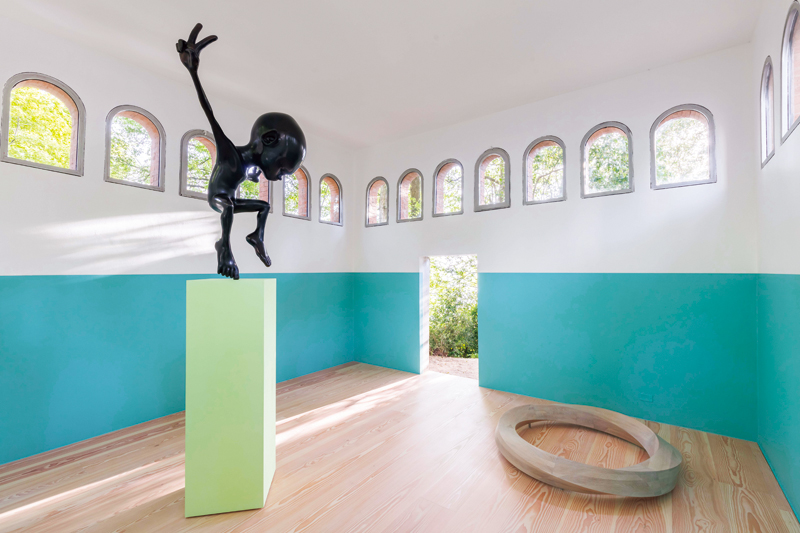
Installation view of KOO JEONG A: ODORAMA CITIES at the Korean Pavilion for the 2024 Venice Biennale. The black sculptural work “OUSSS,” embodying Koo’s unique worldview, releases a puff of scent from its mouth every two minutes.
Courtesy of Pilar Corrias, London, and PKM Gallery, Seoul; photo by Mark Blower
“Nothing is merely ordinary.” This is the philosophy that anchors Koo Jeong A's art, which approaches the everyday from within, demonstrating how patient attention to overlooked elements can reveal profound interconnections. Hovering at the edge of awareness, Koo’s work is tied to traditional Korean aesthetics in which absence carries as much significance as presence — a principle found in ink-wash landscapes and temple architecture. Through quiet manipulations of light, space, and scent, she dissolves artificial divisions.
ORCHESTRATING THE ORDINARY
Born in Seoul in 1967, Koo was introduced to the concepts of value and exchange by her econo-mist father, and to the poetry of everyday spaces by her stay-at-home mother. Educated at École des Beaux-Arts in Paris, she emerged on the art scene during a pivotal period when Korean artists were gaining recognition beyond Western-centric art narratives. essionless figures.
Koo’s 1996 breakout work “Pullover’s Wardrobe” simply consisted of mothballs strategically placed in a Parisian apartment. Visitors first encountered the installation through its distinctive aroma — reminiscent of grandmothers’ cupboards — before identifying its visual source. That same year, Koo presented “Oslo,” transforming pulverized aspirin into miniature mountains and valleys under blue light, a meditative take on ordinary materials that would become her hallmark.
Through these early experiments, Koo established her signature method: activating spaces through ephemeral elements that engage multiple senses, challenging the dominance of vision in Western artistic traditions and demonstrating how beauty emerges not from clarity but from relationships formed in unpredictable configurations. By creating experiences that demand sensory recalibration, Koo invites viewers to discover the extraordinary potential in ordinary materials and moments.
While many contemporary artists overwhelm viewers with scale and technical virtuosity, Koo’s deliberately understated aesthetic invites a form of contemplative engagement rarely experienced in today’s fast-paced visual culture.
Major institutions recognized Koo’s distinctive artistic language, culminating in her 2002 selection as a finalist for the Hugo Boss Prize at the Guggenheim Museum. That year, for her exhibition 3355 Koo spent 24 hours living in Vienna’s Secession gallery, methodically arranging hundreds of cigarettes. The remnants of her presence — cigarette butts, plastic wrappers, personal objects — created a charged atmosphere in which sterile white space confronted the rhythms of human activity.
Similarly, at Yvon Lambert Gallery in New York, seemingly empty spaces revealed stacks of coins arranged like miniature monuments, a nearly imperceptible rotating white cylinder, and scattered glass crystals catching light in unexpected ways. These subtle interventions anticipated her later, more ambitious works that would transform public spaces through equally delicate manipulations of light and material.
“OUSSS” AND LIGHTING
Since 1998, Koo has been working on a concept she calls “Ousss,” which she describes as a “place that is not a place, a world that is not a world, a person that is not a person.” This neologism evolved into “Oussser,” “Ousssology,” and other variants throughout her installations, drawings, and texts. In 2007, she collaborated with the Caribbean philosopher Édouard Glissant to publish “Flammariousss,” a text interpreting the nature of Ousss through a range of expressionless figures.
Ousss further evolved with “MYSTERIOUSSS” and “CURIOUSSSA,” shown in her 2017 Korean exhibition ajeongkoo at Art Sonje Center. These black-and-white 3D animations depict fetus-like characters swimming through space. Koo’s “Dr. Vogt” series, created in 2010 and later exhibited alongside these animations, consists of blue pen drawings presented on a floor lit in fluorescent pink. Together, these works invited viewers into an unfamiliar visual and perceptual experience where simplified character movements and landscapes of remote islands created a dream-like narrative.
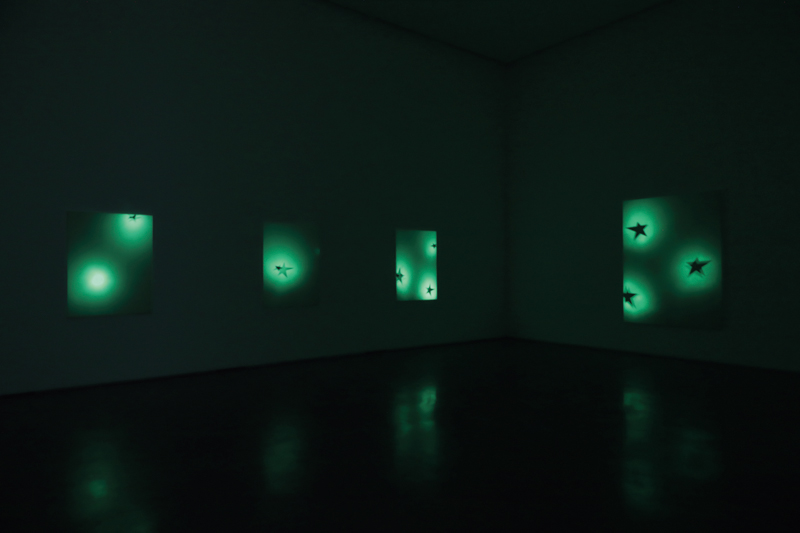
Exhibition view of 2020 at PKM Gallery in 2020. The luminescent painting series “Seven Stars” creates a three-dimensional space that evokes the sensation of drifting through the cosmos once the lights go out, inviting viewers to an unfamiliar world.
Courtesy of the artist & PKM Gallery
Shifting focus, the “Seven Stars” series (2020), shown at PKM Gallery in Seoul, exemplifies Koo’s investigation into the nature of reality itself. Appearing as white canvases under gallery lighting, these works reveal glowing green celestial patterns when the lights are turned off. Viewers must experience these pieces not in one single moment but across different temporal conditions, raising fundamental questions about presence and absence: Are stars present when we cannot see them in daylight?
Korean philosophy has long emphasized the complementary relationship between presence and absence, expressed in the aesthetic principle of yeobaek — meaningful emptiness that activates what surrounds it. Following her participation in the 2020 Busan Biennale, Koo developed the “Seven Stars” series with acclaimed Korean poet Kim Hyesoon, whose abstract metaphors provided what Koo has called “a strange experience” that informed her artistic process. This interdisciplinary exchange demonstrates how Koo continually expands her practice beyond the visual arts.
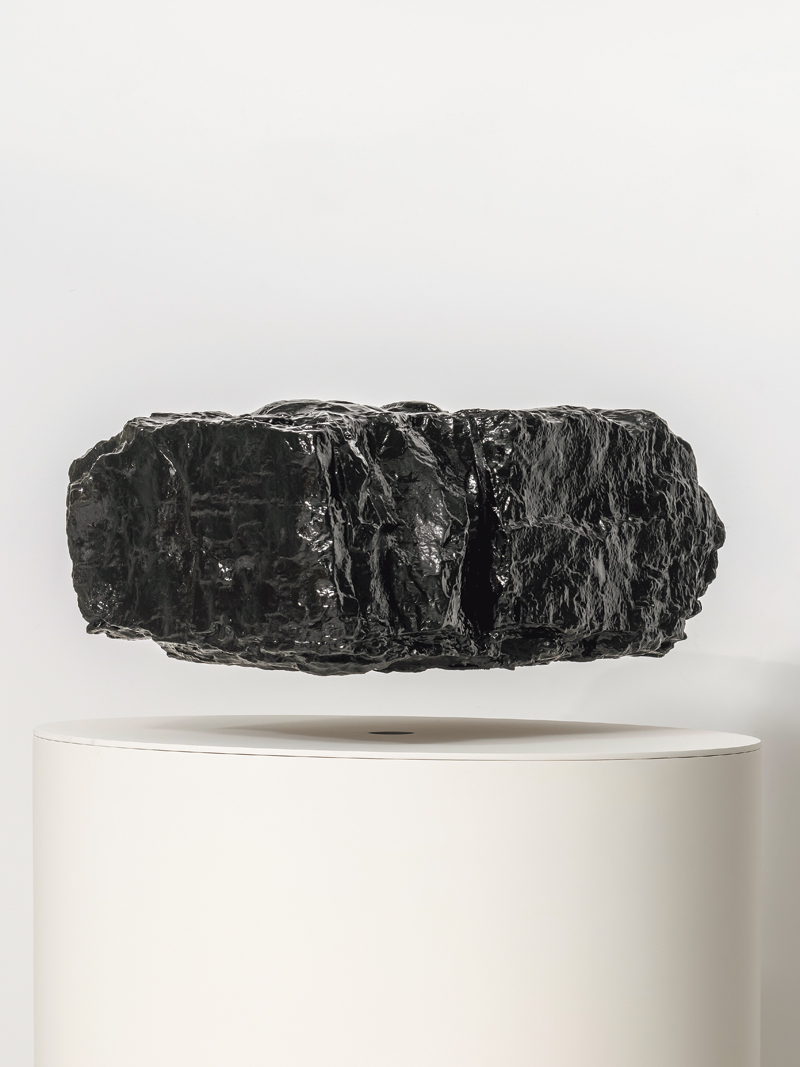
“Density” by Koo Jeong A. 2023. Polyamide, paint, wood, magnetic levitation device. 126.3 × 43.6 × 60.8 cm.
A highlight of the 2023 exhibition Levitation at PKM Gallery, this sculptural piece appears to float against gravity, offering viewers an overwhelming visual experience through its defiance of physical weight.
Courtesy of the artist & PKM Gallery
PUBLIC ART CATALYST
Perhaps nowhere is Koo’s transformative vision more accessible than in her glow-in-the-dark skateboard parks, which shift from ordinary concrete structures during the day to luminous, otherworldly landscapes after dark. Her first such project, “OTRO” (2008), located in rural France, comprises curved concrete bowls and ramps partially set into the land, preserving the natural horizon while creating functional space for community activities.
“I consider the work as something like dressing the deceased in brightness,” Koo told the Guardian in 2015, referencing Korean funerary traditions where light symbolizes transition rather than an end. This poetic interpretation transformed the recreational facilities into contemporary manifestations of traditional wisdom about cycles of presence and absence.
An installation at Everton Park in Liverpool demonstrates how Koo’s artistic vision functions as a catalyst for social transformation. Emerging from extensive collaboration with local youth and the broader skateboarding community, the park features one of the UK’s deepest bowls (nearly three meters) and has helped revitalize a formerly neglected neighborhood.
COLLECTIVE MEMORY
Koo’s art transcends sensory barriers. Her explorations into olfactory experience provided her with the perfect medium to investigate the memory network. Neurological research confirms that smell bypasses conscious thought to connect directly with brain regions associated with emotion, a scientific foundation for Koo’s growing interest in scent as artistic material. Her 2016 “Odorama” transformed an abandoned London Underground platform, with the complex aroma of agarwood evoking the spectral presence of past travelers in the cavernous space.
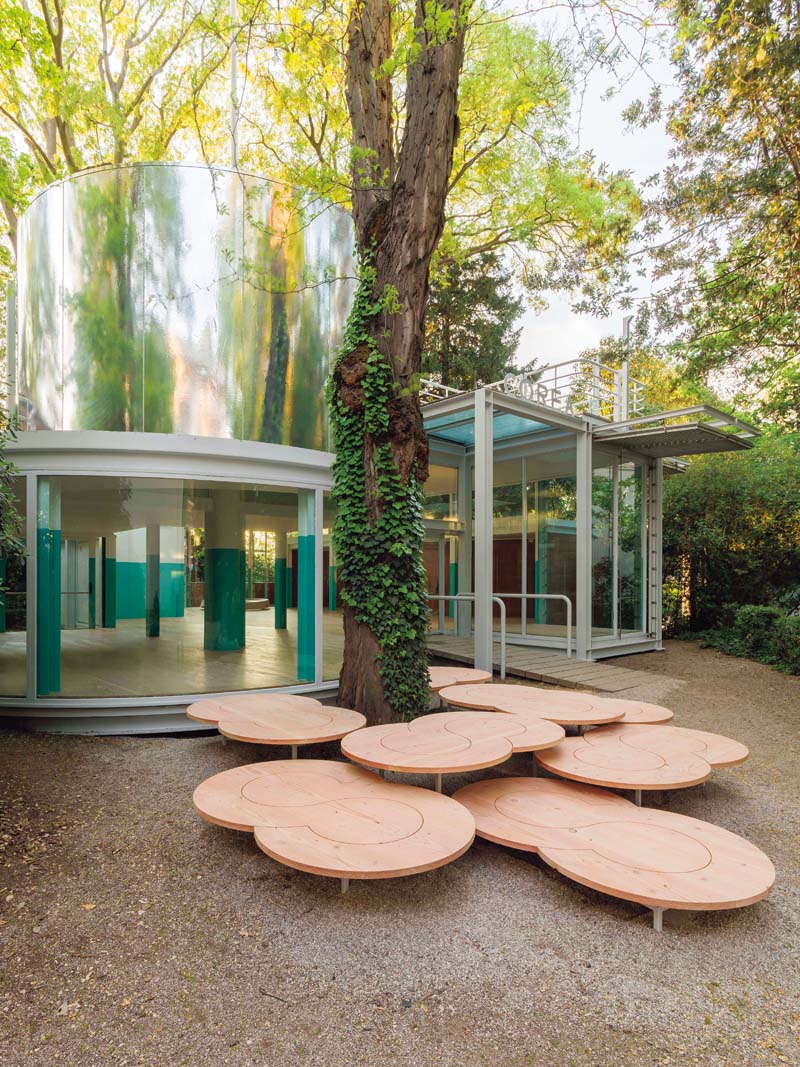
Installation view of KOO JEONG A: ODORAMA CITIES at the Korean Pavilion for the 2024 Venice Biennale. The exhibition explored the expansion of sensory experience through the synesthetic interplay of smell and sight.
Courtesy of Pilar Corrias, London, and PKM Gallery, Seoul; photo by Mark Blower
This and other experiments culminated in ODORAMA CITIES for the Korean Pavilion at the 2024 Venice Biennale, a project of unprecedented scope in Koo’s exploration of collective memory. Rather than imposing a singular narrative of Korean identity, she collected over six hundred personal stories about scent memories from a broad demographic, including Korean nationals, immigrants, adoptees, foreign visitors, and North Korean defectors. Collaborating with Seoul-based perfumer NONFICTION, Koo distilled these narratives into 17 distinct fragrances, creating what she termed a “scent landscape” of Korea.
The minimalist pavilion space centered around a möbius strip-shaped wooden bench, where visitors experienced aromatic compositions evoking a grandmother’s house, the night air, or a public bathhouse, turning the seemingly empty space into an immaterial dimension of shared cultural memory.
BEYOND BORDERS
Throughout her career, Koo has consistently positioned her work not within frameworks of national identity but broader conversations about materiality and perception. Her international recognition stems from her ability to create experiences that transcend cultural specificity, all while maintaining connections to distinctive aesthetic traditions.
“By constructing a portrait of the Korean peninsula, it was totally possible to compose a scent landscape out of people’s immaterial knowledge,” Koo said in an interview with ArtReview. “This portrayal doesn’t provoke any sort of division of nations, but instead unification and togetherness.” In the Korean context, where national division remains a painful reality, her approach offers a powerful alternative to rigid political boundaries, demonstrating how art might navigate complex questions of identity and belonging.
When ODORAMA CITIES came to Seoul’s ARKO Art Center in late 2024, Koo displayed ivory-colored banners bearing fragments of personal narratives throughout the exhibition space. This visual manifestation of collective memory transformed nostalgic recollections into a profound meditation on shared experiences across geographical and political divides. This methodology resonates with broader trends in contemporary art, in which participatory practices increasingly challenge traditional notions of authorship.
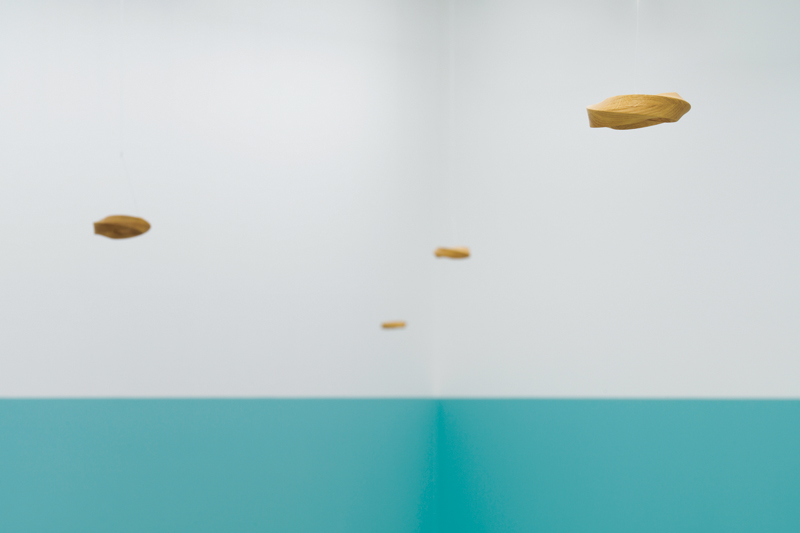
Installation view of KOO JEONG A: ODORAMA CITIES at the homecoming show held at ARKO Art Center in Seoul from December 2024 to March 2025.
Photo by Jeong Kyun Goh
Koo’s approach also reflects broader changes in how European and American institutions contextualize non-Western artists. Unlike previous generations of Korean artists who were often framed through national identity, Koo’s work has been evaluated primarily on its conceptual and experiential merits.
Recent projects reveal Koo’s deepening engagement with scientific and philosophical inquiry. Her 2023 exhibition Levitation at PKM Gallery in Seoul explored themes of gravity, metamorphic rock, and fundamental forces shaping our physical world. Magnetic sculptures titled with historically significant dates (88, 518, 625, 911) invited viewers to contemplate how these numerical markers of collective memory might be reconfigured through different physical arrangements.
Koo frequently references Carlo Rovelli, an Italian theoretical physicist renowned for his work on quantum gravity and accessible writings on the nature of time and reality. “Relationships always come first,” Koo noted in an interview, citing Rovelli’s observation that “the universe has moved from existence to relationships.”
As she prepares for upcoming exhibitions at Haus der Kunst München (2025) in Germany, Aspen Art Museum (2026) in the U.S., and Leeum Museum of Art (2026) in Korea, her work continues to reflect the influence of Édouard Glissant, embodying his “poetry of relations” — a vision that rejects transparency and universality in favor of opacity and diversity. Her art demonstrates how beauty emerges not from clarity but the dynamic formation of relationships in unpredictable configurations.